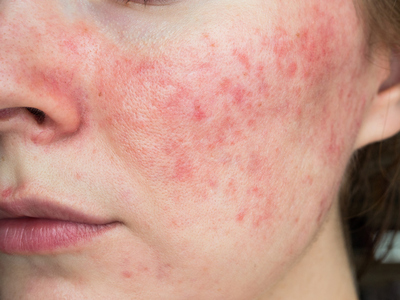Rosacea
 Rosacea is one of the most common skin conditions that affect people of all ages and races. In the United States, rosacea affects more than 16 million people.
Rosacea is one of the most common skin conditions that affect people of all ages and races. In the United States, rosacea affects more than 16 million people.
Rosacea is a skin breakout that causes skin redness, typically around the nose, cheeks, chin, and forehead. Rosacea sometimes looks like an intense blush but can also result in small, red, pus-filled bumps on the skin or red blood vessels on the skin, or your nose might seem redder and more bulbous looking. In some extreme cases, rosacea may affect the eyes.
Causes and Symptoms of Rosacea
While there is not a clear cause for rosacea, it is often triggered by intense exposure to sun and heat, as a reaction to strong emotional situations, and as a reaction to high consumption of caffeine, alcohol, and spicy foods. You could also have a genetic predisposition to rosacea if your parents have suffered from it.
Rosacea has four subtypes, and each subtype has its own symptoms.
- Erythematotelangiectatic Rosacea (ETR) is associated with facial redness, flushing, and visible blood vessels. Its symptoms include redness in the center of the face, broken blood vessels, swollen and sensitive skin, stinging or burning sensations on the skin, and rough and dry skin.
- Papulopustular Rosacea (or acne rosacea) is associated with acne-like breakouts and often affects middle-aged women. Its symptoms include breakouts on the skin (oily and sensitive skin), visibly broken blood vessels, and raised patches of skin.
- Rhinophyma is associated with the thickening of the skin on your nose. It usually affects men and is often accompanied by another subtype of rosacea. Its symptoms include bumpy skin, thick skin on the nose, chin, forehead, cheeks, and ears, large pores, and visibly broken blood vessels.
- Ocular Rosacea affects the eye area and can affect sight if left untreated. Its symptoms include bloodshot and watery eyes, burning sensation in the eye, gritty eyes that feel dry and itchy, sensitivity to light, cyst-like formations in the eye, reduced clarity of vision, and broken blood vessels on eyelids.
For some people, self-care options help keep skin problems under control, but most people will need to consult a dermatologist who can advise them on treatment and medication for their specific skin problem.
Difference Between Acne and Rosacea
Acne and rosacea are often confused with each other since they can sometimes look similar. However, medically, rosacea is very different from acne. Some key differences are listed below:
- While acne results in blackheads, whiteheads, pimples, and cysts, rosacea tends to cause skin redness and pimple-like breakouts, but no blackheads.
- Acne can affect any part of the body. However, rosacea tends only to affect the face area.
- Acne can cause the skin to have a bumpy texture due to blemishes or scars that appear when the acne clears. However, rosacea generally causes blood vessels to be visible in a reddish spread around the face and is accompanied by large pores.
- Usually, those suffering from acne will see redness only around the breakout areas. However, rosacea can spread over a wider area and result in eye problems, such as bloodshot eyes, red and swollen eyelids, and eye discomfort.
- While acne is most commonly found in teens and tweens, rosacea is most common in people in the 30 to 60 year age group.
- Acne is usually a chronic problem, while rosacea occurs in cycles, where the symptoms may appear and stay for a few weeks before disappearing and then returning when triggered.
It is always best to consult a dermatologist to diagnose your skin problem so that an appropriate treatment plan can be recommended and implemented for you.
Treatment Options
For some people, over-the-counter rosacea medications like topical creams can help ease and, in some cases, resolve this skin problem. If such remedies have not worked for you, it may be time to consult an experienced dermatologist who can recommend prescription-strength medication or other treatment options for your skin condition.
Rosacea Treatment
The first step to treating rosacea is to know what triggers it in your body and form habits that help avoid those triggers. And while there is no permanent cure for rosacea, mindful self-care and timely treatment can help you manage skin redness and ease any discomfort. Your dermatologist may suggest medications such as:
- Gels with Brimonidine to tighten blood vessels in the skin to get rid of some redness
- Azelaic acid-based gel and foam to clear bumps, swelling, and skin redness
- Metronidazole cream to treat bumps and inflammation
- Antibiotics (e.g., doxycycline) to kill bacteria on your skin and reduce redness and swelling
Treatment for rosacea can take a few weeks or months to show results. Sometimes, additional procedures, lifestyle modifications, and skincare products may be recommended by your doctor to treat your rosacea. These may include:
- Lasers That Use Intense Light to Treat Swollen Blood Vessels
- Red/Blue Light Therapy
- Stress Management Techniques
- Skincare Products That Don’t Irritate the Skin
Rosacea Treatment at Schweiger Dermatology Group
Schweiger Dermatology Group offers Rosacea Treatment at various locations in NY, NJ, PA, CT, FL, IL, MN, MO and CA. Call us at (844) DERM-DOC to check availability at a location near you.
To find a location near you, check out our location pages. We look forward to working together to find the best treatment for your skin.
